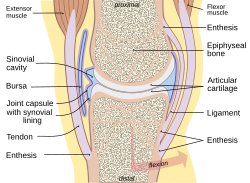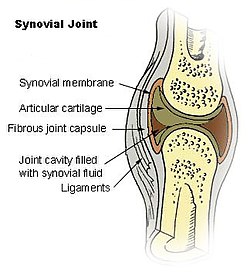Synovial membrane
| Synovial membrane | |
|---|---|

Typical Joint
|
|

Synovial joint
|
|
| Details | |
| Identifiers | |
| Latin | membrana synovialis capsulae articularis |
| Dorlands /Elsevier |
m_08/12522248 |
| TA | A03.0.00.028 |
| FMA | 66762 |
|
Anatomical terminology
[]
|
|
The synovial membrane (also known as synovium or stratum synoviale) is a specialized connective tissue that lines the inner surface of capsules of synovial joints and tendon sheath. It makes direct contact with the synovial fluid lubricant, which it is primarily responsible for maintaining. In contact with the synovial fluid at the tissue surface are many rounded macrophage-like synovial cells (type A) and Fibroblast-like (type B) synovial cells. Type A cells maintains the synovial fluid by removing wear-and-tear debris and type B cells produces hyaluronan among other extracellular components in the synovial fluid.
The synovial membrane is variable but often has two layers
Where the underlying subintima is loose, the intima sits on a pliable membrane, giving rise to the term synovial membrane.
This membrane, together with the cells of the intima, provides something like an inner tube, sealing the synovial fluid from the surrounding tissue (effectively stopping the joints from being squeezed dry when subject to impact, such as running).
Just beneath the intima, most synovium has a dense net of fenestrated small blood vessels that provide nutrients not only for synovium but also for the avascular cartilage.
In any one position, much of the cartilage is close enough to get nutrition directly from the synovium.
Some areas of cartilage have to obtain nutrients indirectly and may do so either from diffusion through cartilage or possibly by 'stirring' of synovial fluid.
The surface of synovium may be flat or may be covered with finger-like projections or , which, it is presumed, help to allow the soft tissue to change shape as the joint surfaces move one on another.
The synovial fluid can be thought of as a specialised fluid form of synovial extracellular matrix rather than a secretion in the usual sense. The fluid is transudative in nature which facilitates continuous exchange of oxygen, carbon dioxide and metabolites between blood and synovial fluid. This is especially important since it is the major source of metabolic support for articular cartilage. Under normal conditions synovial fluid contain <100/mL of leucocytes in which majority are monocytes.
...
Wikipedia
